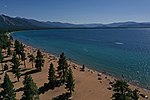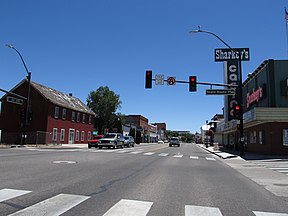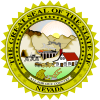Douglas County, Nevada
Douglas County | |
|---|---|
County | |
| Douglas County | |
From top, left to right: View of Stateline from near Heavenly Mountain Resort. Nevada Beach Campground in Zephyr Cove. Douglas County Courthouse in Minden. Downtown Gardnerville. | |
 Logo | |
 Location within the U.S. state of Nevada | |
 Nevada's location within the U.S. | |
| Coordinates: 38°55′N 119°37′W / 38.92°N 119.61°W | |
| Country | |
| State | |
| Founded | 1861 |
| Named for | Stephen A. Douglas |
| Seat | Minden |
| Largest city | Gardnerville Ranchos |
| Area | |
| • Total | 738 sq mi (1,910 km2) |
| • Land | 710 sq mi (1,800 km2) |
| • Water | 28 sq mi (70 km2) 3.8% |
| Population (2010) | |
| • Total | 46,997 |
| • Estimate (2019) | 48,905 |
| • Density | 64/sq mi (25/km2) |
| Time zone | UTC−8 (Pacific) |
| • Summer (DST) | UTC−7 (PDT) |
| Congressional district | 2nd |
| Website | www |
Douglas County is a county in the northwestern part of the U.S. state of Nevada. As of the 2010 census, the population was 46,997.[1] Its county seat is Minden.[2] Douglas County comprises the Gardnerville Ranchos, NV Micropolitan Statistical Area, which is also included in the Sacramento–Arden-Arcade–Yuba City, CA–NV Combined Statistical Area.
History[]
The town of Genoa in Douglas County was the first permanent settlement in Nevada. Genoa was settled in 1851 by Mormon traders selling goods to settlers on their way to California. Named for Stephen A. Douglas,[3] famous for his 1860 Presidential campaign and debates with Abraham Lincoln, Douglas County was one of the first nine counties formed in 1861 by the Nevada territorial legislature.
The county seat is Minden, after having been moved from Genoa in 1915.
Major highways[]
 U.S. Route 50
U.S. Route 50 U.S. Route 395
U.S. Route 395 State Route 28
State Route 28 State Route 88
State Route 88 State Route 206
State Route 206 State Route 207
State Route 207 State Route 208
State Route 208 State Route 756
State Route 756 State Route 757
State Route 757 State Route 759
State Route 759 State Route 760
State Route 760
{{div col end}
Demographics[]
| Historical population | |||
|---|---|---|---|
| Census | Pop. | %± | |
| 1870 | 1,215 | — | |
| 1880 | 1,581 | 30.1% | |
| 1890 | 1,551 | −1.9% | |
| 1900 | 1,534 | −1.1% | |
| 1910 | 1,895 | 23.5% | |
| 1920 | 1,825 | −3.7% | |
| 1930 | 1,840 | 0.8% | |
| 1940 | 2,056 | 11.7% | |
| 1950 | 2,029 | −1.3% | |
| 1960 | 3,481 | 71.6% | |
| 1970 | 6,882 | 97.7% | |
| 1980 | 19,421 | 182.2% | |
| 1990 | 27,637 | 42.3% | |
| 2000 | 41,259 | 49.3% | |
| 2010 | 46,997 | 13.9% | |
| 2020 | 49,488 | 5.3% | |
| U.S. Decennial Census[4] 1790–1960[5] 1900–1990[6] 1990–2000[7] 2010–2018[1] | |||
2000 census[]
As of the census[8] of 2000, there were 41,259 people, 16,401 households, and 11,890 families living in the county. The population density was 58 people per square mile (22/km2). There were 19,006 housing units at an average density of 27 per square mile (10/km2). The racial makeup of the county was 91.9% White, 0.3% Black or African American, 1.7% Native American, 1.3% Asian, 0.2% Pacific Islander, 2.5% from other races, and 2.2% from two or more races. 7.4% of the population were Hispanic or Latino of any race.
There were 16,401 households, out of which 30.7% had children under the age of 18 living with them, 60.5% were married couples living together, 8.0% had a female householder with no husband present, and 27.5% were non-families. 20.7% of all households were made up of individuals, and 6.6% had someone living alone who was 65 years of age or older. The average household size was 2.50 and the average family size was 2.88.
In the county, the population was spread out, with 24.0% under the age of 18, 5.5% from 18 to 24, 26.4% from 25 to 44, 28.9% from 45 to 64, and 15.2% who were 65 years of age or older. The median age was 42 years. For every 100 females there were 102.1 males. For every 100 females age 18 and over, there were 100.7 males.
The median income for a household in the county was $51,849, and the median income for a family was $57,092. Males had a median income of $40,436 versus $28,762 for females. The per capita income for the county was $27,288. About 5.8% of families and 7.3% of the population were below the poverty line, including 9.7% of those under age 18 and 5.3% of those age 65 or over.
2010 census[]
As of the 2010 United States Census, there were 46,997 people, 19,638 households, and 13,519 families living in the county.[9] The population density was 66.2 inhabitants per square mile (25.6/km2). There were 23,671 housing units at an average density of 33.4 per square mile (12.9/km2).[10] The racial makeup of the county was 89.6% white, 1.9% Native American, 1.5% Asian, 0.4% black or African American, 0.1% Pacific islander, 3.2% from other races, and 3.1% from two or more races. Those of Hispanic or Latino origin made up 10.9% of the population.[9] In terms of ancestry, 25.7% were German, 17.5% were English, 14.9% were Irish, 8.0% were Italian, and 4.1% were American.[11]
Of the 19,638 households, 26.7% had children under the age of 18 living with them, 55.5% were married couples living together, 8.9% had a female householder with no husband present, 31.2% were non-families, and 24.0% of all households were made up of individuals. The average household size was 2.38 and the average family size was 2.80. The median age was 47.4 years.[9]
The median income for a household in the county was $60,721 and the median income for a family was $73,543. Males had a median income of $52,001 versus $39,825 for females. The per capita income for the county was $35,239. About 5.4% of families and 7.9% of the population were below the poverty line, including 10.8% of those under age 18 and 6.1% of those age 65 or over.[12]
Communities[]
Census-designated places[]
There are no incorporated towns or cities in Douglas County. The following communities are census-designated places, meaning population and demographic data is available from the U.S. Census Bureau for each one:
Unincorporated communities[]
Politics[]
Historically Douglas was the most Republican county in Nevada, a state that tended to lean Democratic between the 1890s and 1950s. It was the only Nevada county won by Charles Evans Hughes in 1916, and one of only two to vote for Progressive “Bull Moose” ex-President Theodore Roosevelt in 1912. It was also one of only two Nevada counties that voted for incumbent President Benjamin Harrison over insurgent Populist James B. Weaver in 1892 when the latter carried the state by over forty percentage points, and when Douglas did vote Democratic in 1896 and 1900 it was by much smaller margins than the rest of silver-mining Nevada.[13]
The county remains a Republican strong hold.[citation needed]. The last Democrat to carry Douglas County was Franklin D. Roosevelt in 1936 during his 46-state landslide over Alf Landon, and even then FDR received fifteen percent less than his statewide vote share. Apart from FDR's two 1930s wins, Lyndon Johnson in 1964 – when it was one of three Nevada counties to vote for Barry Goldwater – and Barack Obama in 2008 have been the sole Democrats to pass forty percent of the county's vote since 1920.[citation needed]
Economy[]
Major employers[]
- Starbucks roasting plant
- Patmont Motor Werks
- Bently Nevada, part of Baker Hughes
- North Sails
Education[]
Douglas County's education is managed by the Douglas County School District. It serves for all of Douglas County, having two main areas: Lake Tahoe & the Carson Valley. Douglas High School also serves most of the high school age students from Alpine County, California
Lake Tahoe[]
- George Whittell High School
- Zephyr Cove Elementary School
Carson Valley[]
- Douglas High School
- Aspire Academy High School
- Carson Valley Middle School
- Pau-Wa-Lu Middle School
- Gardnerville Elementary School
- Minden Elementary School
- Jacks Valley Elementary School
- Piñion Hills Elementary School
- Gene L. Scarselli Elementary School
- C.C. Meneley Elementary School
Private schools[]
- Sierra Lutheran High School
- Faith Christian Academy
- Grace Christian Academy
Media[]
In popular culture[]
- Smokin Aces
- Charley Varrick
- The Shootist
- Misery
- The Motel Life
See also[]
References[]
- ^ Jump up to: a b "State & County QuickFacts". United States Census Bureau. Archived from the original on June 6, 2011. Retrieved September 23, 2013.
- ^ "County Explorer". National Association of Counties. Retrieved June 7, 2011.
- ^ Gannett, Henry (1905). The Origin of Certain Place Names in the United States. Govt. Print. Off. p. 108. Retrieved January 1, 2016.
- ^ "U.S. Decennial Census". United States Census Bureau. Retrieved December 20, 2014.
- ^ "Historical Census Browser". University of Virginia Library. Retrieved December 20, 2014.
- ^ "Population of Counties by Decennial Census: 1900 to 1990". United States Census Bureau. Retrieved December 20, 2014.
- ^ "Census 2000 PHC-T-4. Ranking Tables for Counties: 1990 and 2000" (PDF). United States Census Bureau. Retrieved December 20, 2014.
- ^ "U.S. Census website". United States Census Bureau. Retrieved January 31, 2008.
- ^ Jump up to: a b c "DP-1 Profile of General Population and Housing Characteristics: 2010 Demographic Profile Data". United States Census Bureau. Archived from the original on 2020-02-13. Retrieved 2016-01-21.
- ^ "Population, Housing Units, Area, and Density: 2010 – County". United States Census Bureau. Archived from the original on 2020-02-13. Retrieved 2016-01-21.
- ^ "DP02 Selected Social Characteristics in the United States – 2006–2010 American Community Survey 5-Year Estimates". United States Census Bureau. Archived from the original on 2020-02-13. Retrieved 2016-01-21.
- ^ "DP03 Selected Economic Characteristics – 2006–2010 American Community Survey 5-Year Estimates". United States Census Bureau. Archived from the original on 2020-02-13. Retrieved 2016-01-21.
- ^ Robinson, Edgar Eugene; The Presidential Vote; 1896–1932 (second edition); pp. 268–270 Published 1947 by Stanford University Press
- ^ Leip, David. "Dave Leip's Atlas of U.S. Presidential Elections". uselectionatlas.org. Retrieved 2018-04-12.
External links[]
- Nevada counties
- Douglas County, Nevada
- 1861 establishments in Nevada Territory
- Populated places established in 1861







